Shell construction is as important as electromagnetic performance- but how do you judge its quality?
by Robert Angus
MOST TESTS of cassette quality concern them selves with the tape itself; in fact, they concentrate almost exclusively on the thin layer of magnetic material on one surface of that tape. In one sense, this is as it should be. A cassette is only as good as the electromagnetic performance of its oxide. But in another sense it also is only as good as its shell, because a tape that jams or skews excessively or breaks won’t deliver the performance that the oxide is capable of.
Testing the mechanical parts of the shell is far more difficult than testing oxide performance, however. There are few accepted standards; mechanical behavior of the shell depends in large part on the transport in which it’s used; and some properties--jamming, for example, are a question of probabilities, rather than repeatable and there fore measurable behavior. So while there are some important clues by which the prospective purchaser can assess the likelihood of mechanical misbehavior, there are no "figures of merit" by which he can compare cassettes-nor even any firm consensus about optimum design in some respects.
Unlike open-reel tapes, whose mechanical handling is performed entirely by the recorder, cassettes become an integral part of the tape-drive system once they're inserted into the transport.
A frequent contributor to both consumer and professional audio journals, Robert Angus was the author of a historical survey of record piracy in HF's December 1976 issue.
The pressure to hold the tape against the magnetic heads comes not from the deck, but from a pressure pad built into the cassette. Some of the guides that help line up the tape for correct azimuth are built into the cassette shell. The shell determines just how freely the tape can move from one hub to the other. And so on. Experienced cassette users, armed with this understanding, have learned that a careful physical examination can lead to some educated guesses about how well, and how long, the cassette is likely to perform.
There are twenty-three parts, more or less, in a well-made cassette. (The exact number depends on who made the cassette and who's doing the counting.) There are legitimate differences of opinion within the tape industry about how these parts should be made and about which ones aren't absolutely necessary.
For example, is a cassette whose two halves are screwed together better than one that is sonically welded? Most premium-priced cassettes use screws, and most quality-conscious tape buyers believe that screws are superior to welding. The reasons are obvious: It's possible to remove screws to make internal repairs when necessary. Or, if you're simply curious about how well the cassette is put together, you can take it apart and see for yourself. But sonic welding is more than a technique for hiding defects or an economical short cut. Ed Hanson, the technical manager of North American Philips (Philips introduced the cassette, and Hanson probably knows more about its internal workings than any other man in the U.S.), points out, "There is no doubt that sonic welding results in a stronger, mechanically more precise cassette-but only if several contributing details and parameters are met." Those parameters include precision molding of parts, proper design of stiffening ridges within the cassette shell, and choice of material to prevent plastic flow. But Hanson notes, "Should the pressure and time cycle of the welding process be incorrect, the result may be either a cassette that is mechanically weak or, at the other extreme, insufficient clearances for the tape and stresses within the welded parts."
Columbia Magnetics feels that the inaccessibility of the interior of a welded cassette is a positive rather than negative feature since it prevents idle fingers from tampering. A spokesman for Memorex adds that when screws are not tightened evenly they are more likely to cause bowing of cassette shells than an even sonic weld along the en tire seam. Toyota Cassettes says that this possibility is overshadowed by the greater likelihood of over-pressing the sonic weld in the sealer, causing the cassette to exceed mechanical tolerances--something far less likely to happen with screws.
But generally the experts are agreed on one point: The presence of screws alone really tells you very little about cassette quality. The possibility of repairing a jammed screw-closure cassette, but not one that is welded, remains.
The physical appearance of the shell itself tells you more than the method of closure does about potential mechanical failure. Is the molding of good quality? Are there rough edges or bits of ex cess plastic in any of the holes on the front edge of the cassette or along the seam? These bits of plastic, known as flash, are the hallmark of sloppy molding (and hence poor mechanical tolerances). So are gaps between the upper and lower halves along the front edge. The edges of the openings at the front of the cassette should be straight and seams should be joined tightly.
Styrene is the basic ingredient of most cassette shells, but the exact type and grade vary from one manufacturer to another, and some producers add chemicals to overcome some of the material's shortcomings. General-purpose styrene has the advantage of being transparent, making it possible to mold the viewing window as an integral part of the cassette shell. Among the manufacturers who use it are Scotch, Audio Magnetics, and Inter magnetics. The main problem with general-purpose styrene is that it tends to shatter easily, so most manufacturers resort to a medium-impact or high-impact styrene for their better cassettes. The trouble with these materials is that their natural color is an opaque ivory (though pigment can be added to the styrene during molding to change its color without altering other properties), so you no longer can see the tape through it.
Pure styrene does have a tendency to lose dimensional stability under some conditions. One of them is heat. If you want a cassette you can leave safely on top of a radiator, it will have to have something added to the styrene. The most common additive is polycarbonate, a surface coating that not only retards warpage due to heat, but also makes the shell less shatter-prone. No matter how closely you examine a cassette, you have no way of knowing whether or not it contains this sort of stabilizer.
Cassette manufacturers make their shells rigid by using the maximum thickness of plastic per mitted by the technical specifications and by molding interior ridges and supports to stiffen the shell against warping or bowing. The intent is to keep the top and bottom from pressing inward, which would inhibit tape movement and misalign the relative positions of the shell, the tape, the recorder's heads, and the drive system.
Windows to permit viewing of the tape pack are generally conceded to be necessary, and most makers feel they should be as large as possible.
When it comes down to particulars, however, consensus weakens. Windows integral to the shell win hands-down approval from most, even though they can be fabricated only in shells of general purpose styrene. Manufacturers using other styrenes must glue or weld the panels or resort to flexible polyester-actually part of the slip sheet.
Some cheap designs use a narrow open slit that offers neither good visibility nor protection from dirt. The rigid window, integral or inserted, offers greatest protection, but there always is the possibility that inserted windows will fall out-or that sonic welding or inexact insertion will create a protuberance inside the cassette.
While most cassette-shell halves look identical, they actually are not. "Whether the halves are a symmetrical or symmetrical doesn't affect the cassette performance if both molds are made with a great deal of care and attention to the accuracy of the tape guiding surfaces," advises John Taylor of the 3M Company. Virtually all manufacturers have found that dissimilar halves facilitate cassette assembly, circumventing problems of tape spill and damage.
There is heated controversy among cassette makers as to whether a resilient foam pad glued directly to the shield or a felt pad glued to a metal spring provides better tape-to-head contact. Even the engineers within BASF are split down the middle on this question; those in Europe are convinced that the small felt pad outperforms a larger foam block, those in the U.S. prefer foam. Memorex, a major advocate of foam, points out that spring pads are more easily damaged. Measurements made by BASF (in this country) show that ...
--------------------
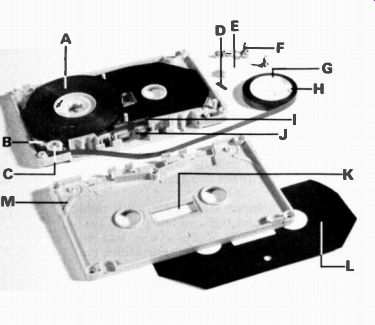
--------- Typical quality construction is visible when this TDK cassette
is opened. Tape pancake (A) feeds past molded stud (B) and idler assembly
(C), which consists of a stainless-steel pin or axle (D) and a flanged
plastic wheel (E). Screws (F) hold shell halves together via molded holes.
Hub (G) has, in this case, a C-clamp tape-end lock (H). Shield (I) is a
plain rectangle of mumetal; pressure pad (J) is felt, mounted on a metal
spring assembly. Viewing window (K) is a separate piece of clear plastic,
neatly and securely attached to shell. Slip sheet (L) covers all of both
pancakes, with cutouts only for hubs and window. Ribs (M) not only stiffen
shell, but help guide tape onto idler wheel.
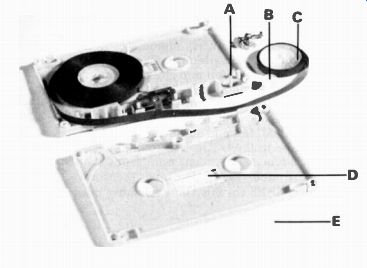
------- When a cassette shell of almost identical external appearance is
opened (this is from KDK-see "News and Views," January 1977),
a number of significant differences are apparent. Stainless axle has
been replaced by a plastic pin (A) molded integrally with shell. Idler
(B) has no flanges; slightly wasp-waisted contour is relied on to keep
tape centered. Tape clamp (C) is same design as that in TDK, but fit is
not nearly as precise. Window (D) appears to be carelessly hand-glued, which
can result in bumps to impede tape motion- particularly since slip sheet
(which otherwise would appear at E) has been omitted.
-----------------
... foam produces more uniform tape-to-head con tact. Norelco notes that "either type of pressure pad can create or cure problems," and 3M in effect concurs, indicating that both types can be de signed to meet Philips specifications.
From the consumer's point of view the important variables (beyond the materials used) appear to be the size of the pad; the care with which it's centered on the tape path; the weight of the spring, if any (metal fatigue can be a problem); the quality of adhesives used; and the frictional characteristics of the pad. For example, some felt pads are actually a thin layer of felt glued to an under-cushion on a copper or beryllium strip. There's some indication that these combination pads produce greater tape-to-head pressure--with resulting friction-than pure felt.
Foam pads, according to their critics, have several drawbacks. They tend to flop over in the direction of tape travel, thus increasing drag and impairing tape-to-head contact. Foam pads--though, like most plastics, they have a restorative "memory"--tend to become deformed over a period of time and exert less pressure against the head. And, says Teac, they may wiggle back and forth during playing. TDK says its tests show that felt is more durable.
All of this may leave you with the feeling that the choice of pressure-pad design is pretty much of a tossup. To a large extent this is true, particularly since you normally have no opportunity to view its construction in advance of purchase. But there is an important moral to be learned: Make a habit of inspecting the pad before you use the cassette, particularly with the more easily damaged spring type. Deformation of the assembly--let alone a pad that has come unglued-means loss of head contact and consequent loss of fidelity.
Behind the pad, whether foam or spring mounted, is a mumetal shield designed to confine the magnetic field created at the recorder head.
Absence of a shield almost certainly would increase noise levels on the tape pack inside the cassette.
Some of these protective devices are simply rectangular plates, while others are C-shaped, with brackets to support the copper or beryllium spring. Memorex and Maxell (in UDXL) use a bathtub-shaped shield. Indications are that all of them do the job and that the bathtub type is not measurably more effective than a well designed and installed rectangle.
When Audio Magnetics introduced leaderless XHE cassettes, some tape hobbyists raised eye brows. Wouldn't the tape tend to stretch at the end of fast forward or rewind? Actually, a number of tape experts-including several who sell cassettes with leaders-agree that there are advantages to the XHE approach. Says Norelco's Hanson, "Leaderless cassettes have been found acceptable for average-length (up to twenty-three minutes) recorded musicassettes. Moreover leaderless cassettes up to sixty minutes in length (whose tape thickness is 18 microns) offer very few problems.
As the tape thickness decreases to 12 microns or less, however, there can be severe looping problems with cassettes that have low internal friction.
It's interesting to remember that the original function of the leader, specified as 1.5 mils thick, was to prevent the capstan in a battery-operated recorder from grinding through the tape, should the ma chine be left on at the end of the run." An Advent spokesman adds that all leader tape is more abrasive than recording tape, so eliminating it should increase head life slightly. Audio Magnetics points to some other advantages: the recordist can begin recording immediately without pre-cueing to the end of the leader or guessing when it has run out; there are no splices-which can be subject to failure. If leaders cause so many problems, why do most manufacturers use them? Because the public expects them, says Advent. The longer the leader, the smoother the tape pack, claims Toyota, because this thicker tape covers the notch or bump at the point where it's attached to the hub. With thin, leaderless tape, pressure of layers above can cause indentations and deformation of the tape itself by the hub. Memorex and Maxell rely on their leader tapes to sweep the heads of iron oxide particles, while 3M notes that leadered tape is less likely than leaderless to pull up over the tape pack, causing a jam, when the cassette suddenly reaches the end in fast forward or rewind. The best reason of all for leader, says a Certron spokesman, is that it increases tape strength at the hub, where breakage is most common.
Also of importance is the way in which the tape or leader is fastened to the hub. Aside from the obvious possibility of failure at this connection, poor design here can affect the entire tape "pancake" and contribute to drag and jamming. The most common fasteners are pins, C-clamps, and one piece latch clamps. To visualize the difference, consider the hub, a perfect circle, with a small notch cut out of it. The leader fits into the notch, and a pin is inserted to hold the tape. Or consider the hub with a cutout area roughly resembling the letter C. A corresponding clamp fits into the space, anchoring the leader at both ends of the clamp. The one-piece latch looks somewhat like a C-clamp except that one end is hinged to the hub itself.
Most automated cassette assembly facilities find the pin the easiest to insert. It provides secure attachment and good leader alignment, but it can form a bump that may deform the tape around the hub. Advocates of the C-clamp point to the advantages of anchoring the tape in two places, not just one. However, if the pin or clamp doesn't fit tightly, the tape can pull out; if the fit is too tight, it ...
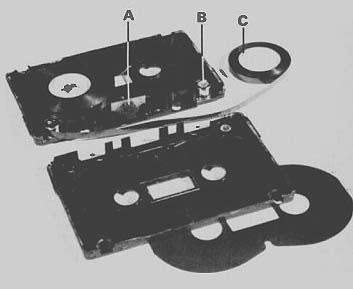
--------- Quality cassettes need not be screw-closed, as explained
in the text. This one, from 3M, is welded and demonstrates a number of other
alternate designs. Pressure pad (A) is large and mounted on foam "spring." Idler
and guide stud are replaced by large, metal-clad stud (B).
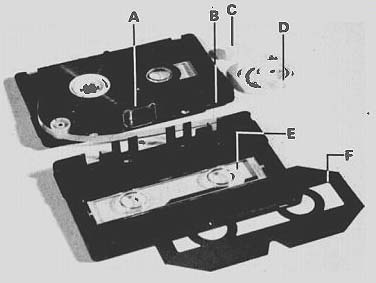
---------------- Tape clamp (C) is integrally molded with hub. When Memorex
entered the cassette market, it designed its own shell from the ground
up, with results that are still unique in some respects. Foam-mounted
pressure pad is housed in "bathtub" shield (A) for maximum protection
of tape head from stray hum fields. Molded axle (B) holds oversize, flanged
idler (C). Tape clamp (D) is pin, held in narrow notch. Huge window (E)
offers tape visibility exceeded only by transparent-shell cassettes and
requires specially shaped slip sheet (F).
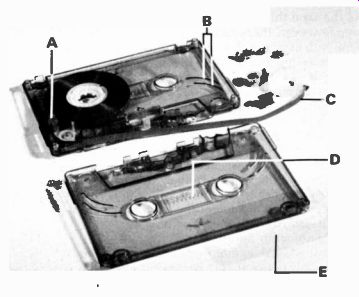
--------------- So-called special mechanics (a term actually introduced
by BASF for a different design) are introduced into this Audio Magnetics
cassette as a "floating" plastic guide (A) that travels in slot
between two ribs (B) and guides tape between pancake and idler wheel.
This is one of the leaderless designs in which tape end (C) is attached
directly to hub. Window (D) is distinguished from rest of transparent shell-of
which it’s an integrally molded part-only by relief "frame" that
surrounds it. To preserve transparency, small slip sheet (E) also is made
of clear plastic.
------------------
... can cut the leader during assembly. 3M's solution is a one-piece latch that eliminates possible differ ences in the dimensions of pin or clamp and hub by making both part of the same mold.
Just inside the left and right front corners of the cassette shells are two very important little sub systems for tape guidance. The main element of each generally is an idler or flanged wheel, riding on an "axle" that may be a separate metal pin (usually of stainless steel) or a post molded as part of the shell. Just "beyond" the idlers--that is, toward the hubs and away from the head openings in terms of the tape guidance path-there generally are two fixed posts over which the tape must pass on its way from the hub to the idler.
Some manufacturers use a fixed post instead of the idler wheel. 3M is one company that uses both: While an idler assembly, plus controlled drag to prevent slack tape on the supply-hub side, is used in its more expensive products, its least expensive ones have fixed posts that guide the tape and con tribute the needed hold-back drag. Both types can be made to meet international specification limits, says 3M, as long as the post is designed with a sleeve or other modification that will provide the accuracy of guidance and drag required. Recorded cassettes often get away with a simple, unmodified post-but only because they contain significantly less tape than a C-60. Norelco's Hanson believes that there is only one answer to this design question: flanged rollers of Delrin or Celcon on stainless-steel axle pins.
Recently, however, there have been flanged rollers mounted on triangular molded plastic pins that ride on a larger center hole and, Hanson finds, meet high fidelity requirements.
The flanges on the roller must be wide enough to permit the tape to move freely, while also keeping it in proper position relative to the recorder head.
The size of the flange, the angle at which it's tapered and the precision of the molding all are important. The diameter of the roller, too, is a factor.
Capitol, f or example, uses oversize rollers to smooth tape movement. Roller problems may occur when the axles are either plastic or conventional, nonstainless steel. It's virtually impossible, some manufacturers believe, to mold plastic pins to exact tolerances; and conventional steel rusts, causing friction. The opposite camp counters that even stainless pins can be mounted so that they're not perpendicular, resulting in extra friction and in tape skewing, and that integrally molded axles are always the same from sample to sample.
Finally, there's the matter of the slip sheets-the plastic sheets that fit between the tape pack and the cassette shell. Their function is to remove static charge and to control the movement of the tape within the cassette by exerting just enough pressure on the pack during play or fast wind to keep it flat. Antistatic electrical conductors like graphite and films like Teflon and polyester frequently are used, with graphite-loaded Teflon the most widely accepted. Its frictional characteristics are uniform, and it provides a cassette with long term stability under a wide range of storage and operating conditions. Philips in Europe, and Capitol in the U.S., use pleated slip sheets to control the tape for flatter pancakes than are otherwise possible. (Special mechanics-floating guides built into the shell itself by BASF and Audio Magnetics--attempt to do the same thing.) In addition, they lessen the tension at the end of the tape during fast winding. Some manufacturers use paper slip sheets; Certron's have silicone impregnation.
Which is better--Teflon, paper, or polyester film? Opinions vary with the manufacturer, who must consider factors like the low cost of paper, the greater stiffness and resistance to wear of poly ester, the desirable electrical and frictional properties of Teflon. Since graphite may rub off on the tape pack and find its way onto tape guides or recorder parts, some manufacturers use slip sheets with the graphite impregnated in, rather than coated on, the outside.
The amount of tape inside the cassette shell plays an important part in the over-all design.
Again, you can get away with things in a C-30 (or a thirty-minute recorded cassette) that would never work in a C-90 or C-120. TDK has taken advantage of the extra space inside its C-45 cassettes to experiment with an oversized hub that provides lower torque than the conventional hub, for gentler tape handling.
TDK also addresses itself to the opposite end of the duration spectrum. Its C-180 looks to the un trained eye like a well-designed C-60 or C-90, even when you take it apart. If there is a difference be tween this and other cassettes, it's in the slip sheet: a piece of high-density graphite-impregnated polyethylene. Despite the absence of any special mechanics, TDK has had virtually no complaints of jamming or other mechanical problems with these cassettes.
If that's the case, why are tape dealers so reluctant to recommend and hobbyists so reluctant to use C-120 cassettes? "Bad early experience," answers Advent. "Today, a properly designed and manufactured C-120 is almost as reliable as a C-90." Radio Shack points out that the thinner tape coating puts a limitation on recording level, particularly in low frequencies; Maxell adds that there's greater print-through; Capitol says that the thinner tape is much more likely to stretch when subjected to undue stress.
There are, in sum, reasons for avoiding the longer cassettes: somewhat restricted electro magnetic performance and somewhat greater chance of mechanical failure by contrast to C-90s and, especially, C-60s. But the present C-120s (and C-180s) hardly merit the outright embargo so often placed on their use as a result of past waywardness. And the improvement is not necessarily in the cassettes themselves; a fragile cassette is less likely to misbehave in a modern deck with well controlled transport mechanics than in the relatively crude designs that once were common- though such designs linger on in inexpensive decks and battery portables.
But usually fragility is not what makes one "major brand" less desirable than another in terms of mechanical performance. The criterion today is not whether the tape will move, but how accurately it will move. As a gauge of this, there is growing concern with tape skew.
All cassette tapes skew; that is, they "wiggle" as they pass the heads so that tape-to-head alignment varies, in both azimuth and height, from moment to moment. If all elements over which the tape passes in moving from supply hub to take-up hub are perfectly aligned in a single plane and intro duce no wobble or other motion of their own--and are consistent in the friction they present to the tape-skew should remain at a minimum. Skew is affected by all of the design considerations discussed in this article, and therefore its measurement might be expected to serve as an index of the cassette's mechanical quality.
Unfortunately, it can only be measured in an operating deck (for example, by comparing phase between channels with an identical test signal recorded on both), and that means that any measurement perforce includes skew induced by the deck itself. In other words, two cassettes that display identical skew on one machine might not be equally good when measured on another. And no standard method of measuring skew or expressing the results of those measurements has been adopted by the industry. But there is hope for the development of an acceptable cassette-measurement technique along these lines.
In the meantime, the prospective purchaser must base his assessment of mechanical performance on two primary factors: his experience with a given brand in his own recorder (just because one brand behaves itself in your neighbor's is no guarantee that it will in yours) and an examination of those visible details that bespeak care or sloppiness in design and assembly. Imprecise molding does show: as flash, as poorly mated parts, as un evenly shaped surfaces. Look also for pressure pads that are askew. Even carelessly affixed labels bespeak a want of craftsmanship. If all else fails to show up a winner in a comparison, try shaking the cassettes. Hubs and other free parts will clatter about to some extent in any cassette; but if the ones you are testing sound like a child's rattle, you can be reasonably sure that internal tolerances are too great for reliable performance.
The acid test, however, is use. Because your deck interacts mechanically with the cassettes you use, each is only as good as its performance in combination with the other.
++++++++++++++++++++++
-------------
(High Fidelity, Feb 1977)
Also see:
Will the Elcaset Make It? by Larry Zide